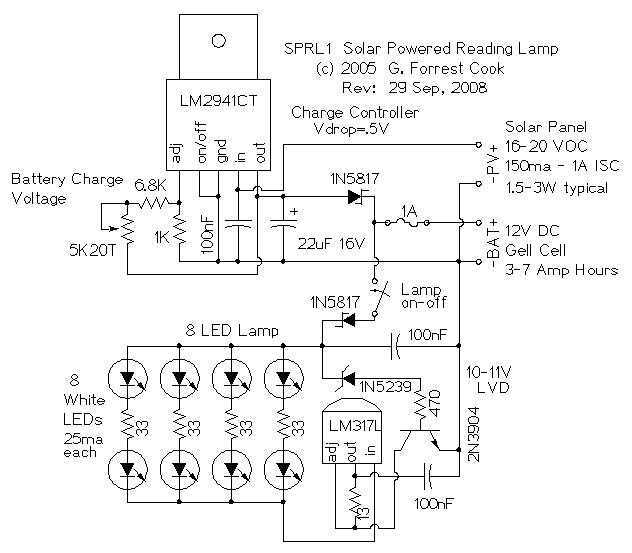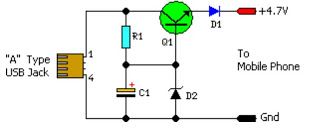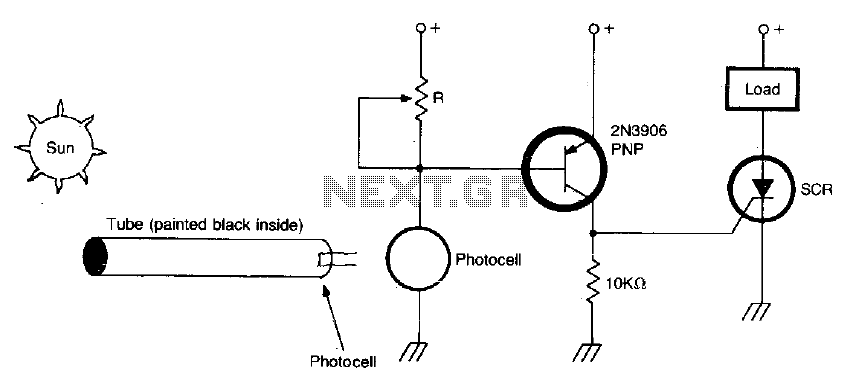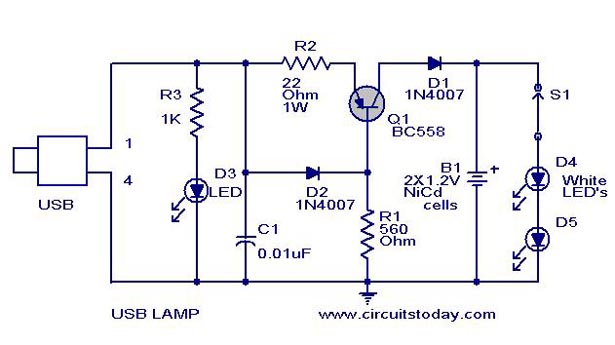
Solar Powered Reading Lamp

The reading lamp consists of a small solar panel, a standard UPS style lead acid battery, and an LED circuit board. The circuit board contains a low power solar charge controller (regulator), a set of 8 white LEDs, a switch, an LED current regulator, and a low voltage disconnect circuit. The circuitry will insure a long battery life by preventing over charging and excessive discharging. The circuit was designed to work with lead acid batteries, it should also work with a string of 10 NiCd cells. Both the charge controller and LED regulator circuits can be used independently for other applications. More: Newer VW and Audi automobiles come with small solar panels for keeping the battery charged in the sales lot. These panels are available on eBay for around $15 and are a perfect fit for this project. An inexpensive 12V 7AH lead acid gell-cell battery that
The reading lamp circuit is designed to harness solar energy effectively for sustainable lighting solutions. The primary components include a small solar panel, which converts sunlight into electrical energy, a lead-acid battery for energy storage, and an LED circuit board that provides illumination.
The solar panel is typically rated for a specific voltage and current output, sufficient to charge the lead-acid battery. This panel is connected to the low-power solar charge controller, which regulates the voltage and current coming from the solar panel to ensure safe charging of the battery. The charge controller prevents overcharging by disconnecting the solar panel when the battery reaches a fully charged state, thus prolonging the life of the battery.
The lead-acid battery, often a 12V 7AH gel-cell type, serves as the energy reservoir for the lamp. This type of battery is favored for its reliability, cost-effectiveness, and ability to provide stable power output. The circuit board includes a low voltage disconnect (LVD) feature that protects the battery from excessive discharge, which can lead to sulfation and reduced capacity. The LVD disconnects the load (in this case, the LEDs) when the battery voltage drops below a predetermined threshold.
The LED circuit board features eight white LEDs that provide efficient illumination. The LEDs are driven by an LED current regulator that ensures they operate within their specified current limits, enhancing their lifespan and performance. A switch is incorporated into the design, allowing users to turn the lamp on or off as needed.
This circuit is versatile; while it is optimized for lead-acid batteries, it can also accommodate a string of 10 NiCd cells, providing flexibility in battery choice. Additionally, both the charge controller and LED regulator can be repurposed for other applications, making this design adaptable to various energy storage and lighting needs.
In summary, this solar-powered reading lamp circuit exemplifies a practical application of renewable energy technology, featuring a well-thought-out design that prioritizes battery longevity and efficient LED operation.The reading lamp consists of a small solar panel, a standard UPS style lead acid battery, and an LED circuit board. The circuit board contains a low power solar charge controller (regulator), a set of 8 white LEDs, a switch, an LED current regulator, and a low voltage disconnect circuit.
The circuitry will insure a long battery life by preventing over charging and excessive discharging. The circuit was designed to work with lead acid batteries, it should also work with a string of 10 NiCd cells. Both the charge controller and LED regulator circuits can be used independently for other applications.
Newer VW and Audi automobiles come with small solar panels for keeping the battery charged in the sales lot. These panels are available on eBay for around $15 and are a perfect fit for this project. An inexpensive 12V 7AH lead acid gell-cell battery that 🔗 External reference
The reading lamp circuit is designed to harness solar energy effectively for sustainable lighting solutions. The primary components include a small solar panel, which converts sunlight into electrical energy, a lead-acid battery for energy storage, and an LED circuit board that provides illumination.
The solar panel is typically rated for a specific voltage and current output, sufficient to charge the lead-acid battery. This panel is connected to the low-power solar charge controller, which regulates the voltage and current coming from the solar panel to ensure safe charging of the battery. The charge controller prevents overcharging by disconnecting the solar panel when the battery reaches a fully charged state, thus prolonging the life of the battery.
The lead-acid battery, often a 12V 7AH gel-cell type, serves as the energy reservoir for the lamp. This type of battery is favored for its reliability, cost-effectiveness, and ability to provide stable power output. The circuit board includes a low voltage disconnect (LVD) feature that protects the battery from excessive discharge, which can lead to sulfation and reduced capacity. The LVD disconnects the load (in this case, the LEDs) when the battery voltage drops below a predetermined threshold.
The LED circuit board features eight white LEDs that provide efficient illumination. The LEDs are driven by an LED current regulator that ensures they operate within their specified current limits, enhancing their lifespan and performance. A switch is incorporated into the design, allowing users to turn the lamp on or off as needed.
This circuit is versatile; while it is optimized for lead-acid batteries, it can also accommodate a string of 10 NiCd cells, providing flexibility in battery choice. Additionally, both the charge controller and LED regulator can be repurposed for other applications, making this design adaptable to various energy storage and lighting needs.
In summary, this solar-powered reading lamp circuit exemplifies a practical application of renewable energy technology, featuring a well-thought-out design that prioritizes battery longevity and efficient LED operation.The reading lamp consists of a small solar panel, a standard UPS style lead acid battery, and an LED circuit board. The circuit board contains a low power solar charge controller (regulator), a set of 8 white LEDs, a switch, an LED current regulator, and a low voltage disconnect circuit.
The circuitry will insure a long battery life by preventing over charging and excessive discharging. The circuit was designed to work with lead acid batteries, it should also work with a string of 10 NiCd cells. Both the charge controller and LED regulator circuits can be used independently for other applications.
Newer VW and Audi automobiles come with small solar panels for keeping the battery charged in the sales lot. These panels are available on eBay for around $15 and are a perfect fit for this project. An inexpensive 12V 7AH lead acid gell-cell battery that 🔗 External reference




